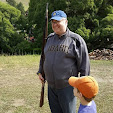The figures are Sash and Saber pack US1 "Federal Infantry Command Advancing (Right Shoulder Shift). The flag staffs are Old Glory PSJ-02 "Long Thrusting Spears with Cast Tips," which I cut down from 70mm to 55mm length. The flag tops are Front Rank EQ52 "Flag Tops with Tassels." The flags are all GMB. The bases are Litko 3mmx30mmx40mm rectangles. The flocking is Woodland Scenics Fine Brown Ballast drybrushed with Delta Ceramcoat's "Light Chocolate" and spotted with static grass.
 Close-up of Command Stands (click for larger image)
Close-up of Command Stands (click for larger image)Here they are, flags and tassels fluttering in the breeze. When I ordered my army, I asked for extra Union standard bearers so I could field national and regimental colors for each regiment. The extras I received were all the same pose (the beardless one), so my color parties look a little more uniform than I would like.
I ordered the flags from The Miniature Service Center during their GMB close-out sale, so I had to take what they had available. The result is a lot of New York and Massachusetts regiments. Fortunately, the flags have some variety, with two white Massachusetts regimental colors and one Irish Brigade flag (69th New York). One of those flags is for the 7th Wisconsin, so I really should have a regiment in Hardee hats, but hopefully no one will leave my table in a huff over my historical inaccuracy.
I like this view. You can really see just how beautiful those GMB flags are. I was worried that the color might run when I lacquered the figures, but this picture is post-lacquering and dullcoating, and it seems that they've held up well.






























